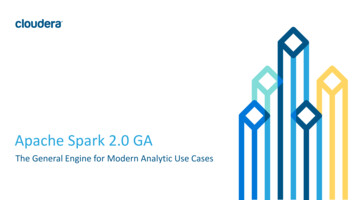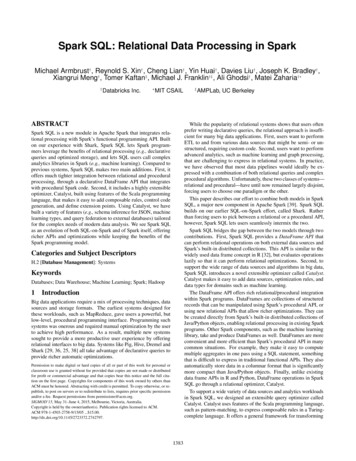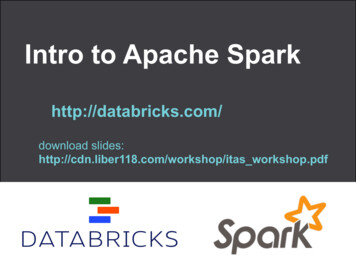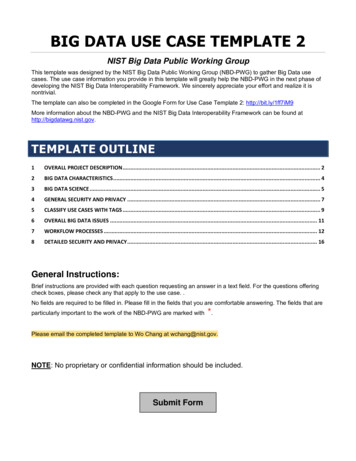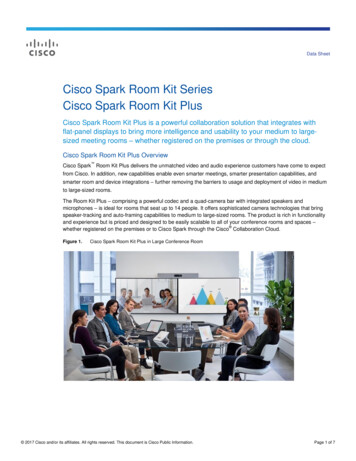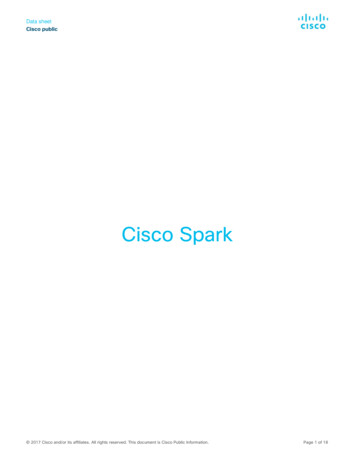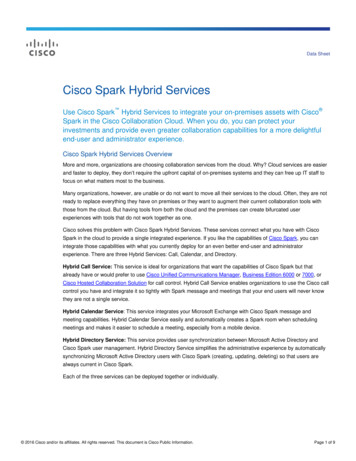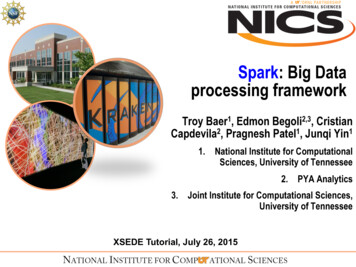
Transcription
Spark: Big Dataprocessing frameworkTroy Baer1, Edmon Begoli2,3, CristianCapdevila2, Pragnesh Patel1, Junqi Yin11. National Institute for ComputationalSciences, University of Tennessee2. PYA Analytics3. Joint Institute for Computational Sciences,University of TennesseeXSEDE Tutorial, July 26, 2015
Outline Overview of Big Data processing framework Introduction to Spark and Spark deployment Introduction to Spark SQL and Streaming Hands-on Spark machine learning and graph libraries Hands-on2Spark@NICS/JICS, XSEDE 2015
Overview of Big Dataprocessing framework
A brief history of Hadoop4Spark@NICS/JICS, XSEDE 2015
Why large scale (‘Big Data’) analytics Heterogeneity of the architecture– Mixed loads– Mixed types Comprehensiveness of the analytic tools– SQL– Machine Learning– Data manipulation– Programming– External libraries “Safe-bet” for the future5Spark@NICS/JICS, XSEDE 2015
A general case for ‘Big Data’ in healthcare‘Big Data’ PlatformFinancial and administrative dataPersonal/genomic dataClinical data6Image and sensor data
Value of data ty and Size od Data Sets7ValuePatientSpecific
Hadoop: Big Data Platform Hadoop has become the de-facto platform for storingand processing large amounts of data.1. Storage managers : HDFS, HBASE, Kafka, etc.2. Processing framework: MapReduce, Spark, etc.3. Resource managers: Yarn, Mesos, etc.8Spark@NICS/JICS, XSEDE 2015
MapReduce programing model (2004) Mappers perform a transformation Reducers perform an aggregation9Spark@NICS/JICS, XSEDE 2015
Beyond MapReduce paradigm Extends map/reduce model to Directed Acyclic Graph(DAG) model with backtracking-based recovery( Apache Tez 2007) Implementation of above recovery with ResilientDistributed Datasets (RDD)(Apache Spark 2010) Extend DAG model to cyclic graphs(Apache Flink 2012)10Spark@NICS/JICS, XSEDE 2015
Hadoop ecosystemHiveApplicationsMapReduceData processingframeworksSparkStormApp and ResourcemanagementHDFSFlinkTezYarnStorage management11 PigMesosHBaseSpark@NICS/JICS, XSEDE 2015
Overview of Big Data processingframeworks Categories of processing frameworks1. General-purpose processing framework: allow users toprocess data using a low-level API, e.g. MapReduce, Spark andFlink2. Abstraction frameworks: allow users to process data using ahigher level abstraction, .e.g. Pig3. SQL frameworks: enable querying data, e.g. Hive, Impala12Spark@NICS/JICS, XSEDE 2015
Overview of Big Data processingframeworks Categories of processing frameworks4. Graph processing frameworks: enable graph processingcapabilities, e.g. Giraph5. Machine learning frameworks: enable machine learninganalysis, e.g. MLlib, Oryx6. Real-time/streaming frameworks: provide near real-timeprocessing (several hundred milliseconds to few secondslatency), e.g. Spark Streaming, Storm13Spark@NICS/JICS, XSEDE 2015
Overview of Big Data processing framework14Spark@NICS/JICS, XSEDE 2015
Uses in the real world – observedArchitectures Three models in the modern enterprises– MPP Hadoop as NAS/ETL– Hadoop/Spark as a first class citizen for analytic discovery– Facebook architecture – the only citizen15Spark@NICS/JICS, XSEDE 2015
Stereotypical Architecture16Spark@NICS/JICS, XSEDE 2015
Some Interesting Emerging Use Cases Near-real time decision making in healthcare regardingcritical medical conditions Bioinformatics and genomic applications (ADAM,SparkSeq) Authorship graph (PYA Analytics, later)17Spark@NICS/JICS, XSEDE 2015
Introduction to Sparkand Spark deployment
Spark: Big Data processing framework Spark is fast, general-purpose data engine thatsupports cyclic data flow and in-memory computing. Advantages over Hadoop MapReduce1. Speed : 100x faster inmemory; 10x faster on disk2. Ease of use: supportsprogram in Java, Scala orPython19Logistic regressionSpark@NICS/JICS, XSEDE 2015
Spark: Big Data processing framework Advantages over Hadoop MapReduce– Generality: combines SQL, streaming, machine learning andgraph processing capabilities– Speed– Compatibility: runs on Hadoop, standalone, or cloud20Spark@NICS/JICS, XSEDE 2015
Spark Architecture Resilient DistributedDatasets (RDD) :distributed objects that canbe cached in-memory,across a cluster ofcompute nodes. Directed Acyclic Graph(DAG) execution enginethat eliminates theMapReduce multi-stageexecution model21Spark@NICS/JICS, XSEDE 2015
Operations on RDD Transformation: specifiesthe processing dependencyDAG among RDDs Action: specifies what theoutput will be The scheduler performs atopology sort to determinethe execution sequence ofthe DAG22Spark@NICS/JICS, XSEDE 2015
Operations on RDD Narrow transformation( involves no data shuffling):Map, FlatMap, Filter, andSample Wide transformation(involves data shuffling):SortByKey, ReduceByKey,GroupByKey, Join, etc Action: Collect , Reduce,ForEach, Count, Save, etc.23Spark@NICS/JICS, XSEDE 2015
Operations on RDD24Spark@NICS/JICS, XSEDE 2015
Spark examples In-Memory Text Searchval file spark.textFile("hdfs://.")val errors file.filter(line line.contains("ERROR")).cache()// Count all the errorserrors.count()// Count errors mentioning MySQLerrors.filter(line line.contains("MySQL")).count()// Fetch the MySQL errors as an array of stringserrors.filter(line , XSEDE 2015
Spark examples Word Countval file spark.textFile("hdfs://.")val counts file.flatMap(line line.split(“ ")).map(word (word, 1)).reduceByKey( )Counts.saveAsTextFile(“hdfs:// ”)26Spark@NICS/JICS, XSEDE 2015
Spark Deployment Modes Spark local Spark with HDFS and YARN or MESOS Res. Mgrs. Spark on HPC (Thursday) Spark and Tungsten (new research)27Spark@NICS/JICS, XSEDE 2015
Spark Standalone Core Spark Local file system, compute and memory space Practical for learning and monster CPU/RAM machines28Spark@NICS/JICS, XSEDE 2015
Spark deployment on Cluster In cluster mode, the Sparkruntime environment consistsof a driver program, a clustermanager, and workers oncompute nodes. Cluster manager is responsiblefor allocating and startingworkers as well as coordinatingcommunication between thedriver program and workers. Spark supports YARN, Mesos, and standalone mode.29Spark@NICS/JICS, XSEDE 2015
Spark deployment on Cluster At NICS, we provides “Spark on demand” within thecontext of a PBS batch or interactive job. The key tool is pbs-spark-submit k/bin/pbs-spark-submit) pbs-spark-submit work flow:1. Verifies execution is inside a PBS job2. Sets default value for a number of environmentvariables30Spark@NICS/JICS, XSEDE 2015
Spark deployment on Cluster pbs-spark-submit work flow:3. Determines what shared and node-local directories touse.4. Parses its command line options and updates settings5. Parses any Java property files found in itsconfiguration directory6. Launches the Spark master and worker daemons7. Executes user’s Spark driver program31Spark@NICS/JICS, XSEDE 2015
Spark deployment on ClusterFor more details, please attend the talk on“Integrating Apache Spark Into PBS-Based HPCEnvironments” by Edmon Begoli32Spark@NICS/JICS, XSEDE 2015
Introduction to SparkSQL and Streaming
Spark SQL Load data from a variety of structured sources– JSON, Hive, and Parquet Query data using SQL– From inside a Spark program– From external tools that connect through JDBC/ODBC Rich integration between SQL and Scala/Java/Python– Join RDDs and SQL tables– Custom functions in SQL34
Spark SQL Shark, a backend modified Hive running over Spark.– Limited integration with Spark– Hive optimizer not designed for Spark Spark SQL reuses parts of Shark,– Hive data loading– In-memory column store Spark SQL also adds– RDD-aware optimizer– Rich language interfaces35
Spark SQL components Catalyst OptimizerSpark SQL– Relational algebra plus expressions– Query optimization Spark SQL core– Execution of queries as RDDs– Reading in Parquet, JSON, etc Hive Support– HQL, MetaStore, SerDes, UDFs36Hivesupport26%SQL core36%CatalystOptimizer38%
Query execution stepsParseAnalyzeLogical PlanCatalystOptimizeExecutionSQL core37Logical Plan
Using Spark SQL SQLContext– Entry point for all SQL functionality– Wraps/extends existing spark contextval sc: SparkContext // An existing SparkContextval sqlContext neworg.apache.spark.sql.SQLContext(sc)// importing SQL context gives access to all SQLfunctionsimport sqlContext.38
DataFrame A DataFrame is a distributed collection of dataorganized into named columns Equivalent to table in relational database or data framein R/Python, but with richer optimizations DataFrame API is available in Scale/Java/Python A DataFrame can be created from an existing RDD, aHive table, or data sources.39
DataFrame operations// Create the DataFrame from data sourceval df sqlContext.jsonFile(“people.json”)// show the content of the DataFramedf.show()//age name// null Michael// 30 Andy// print the schema in a tree formatdf.printSchema()//root// /-- age: long (nullable true)// /-- name: string (nullable true)40
DataFrame operations// select only the “name” / Andy// select people older than 21df.filter(df(“age”) 21).show()//age name// 30 Andy// count people by agedf.groupBy(“age”).count().show()//age name41
Turning RDD into DataFrame// Define the schema using a case classcase class Person(name: String, age: Int)// Create an RDD of Person objectsval people sc.textFile(“people.txt”).map( .split(“,”)).map(p Person( p(0), p(1).trim.toInt)).toDF()//register RDD as an tablepeople.registerTempTable(“people”)42
Querying using SQL// SQL statements are run with the sql method from// sqlContextval teenagers sql(“SELECT name FROM peopleWHERE age 10 AND age 19”)// The results of query are SchemaRDDs but also// support normal RDD operations.// The colums of a row in the result are accessed by// ordinalval nameList teenagers.map(t “Name: “ t(0)).collect().foreach(println)43
Querying using Scala DSL Express queries using functions, instead of SQL strings// The following is the same as:// SELECT name FROM people// WHERE age 10 AND age 19val teenagers people.where(‘age 10).where(‘age 19).select(‘name)44
Caching Table in memory// Spark SQL can cache tables using in memory// columnar format:cacheTable(“people”) or people.cache() Scan only required columns Fewer allocated objects Automatically selects best compression45
Parquet Compatibility Native support for reading data in Parquet– Columnar storage avoids reading unneeded data– RDDs can be written to parquet files, preserving the schema// SchemaRDD can be stored as / Parquet files are self-describingval parquetFile uet files can be used in SQL ��)val teenagers sql(“SELECT name FROM peopleWHERE age 10 AND age 19”)46
Hive compatibility Support for writing queries in HQL Catalog info from Hive MetaStore Tablescan operator that uses Hive SerDes Wrappers for Hive UDFs, UDAFs, UDTFsval hiveCtx new ql(“CREATE TABLE IF NOT EXISTS src (key INT,value STRING)”)hiveCtx.sql(“LOAD DATA LOCAL INPATH ‘’kv1.txt’ INTOTABLE src)hiveCtx.sql(“FROM src SELECT key, value”).collect()47
Spark SQL UDFs Build-in method to easily register UDFs//Make a UDF to tell us how long some text issqlContext.udf.register(“strLen”, (s:String) s.length() )sqlContext.sql( “ SELECT strLen(‘name’) FROMpeople).collect().foreach(println) Use existing Hive UDFshiveCtx.sql(“CREATE TEMPORARY FUNCTION nameAS class.function”)48
JDBC server and Beeline client Spark SQL provides JDBC connectivity, which is usefulfor connecting MySQL, PostgreSQL, etc database andbusiness intelligence tools.//lanching the JDBC serverstart-thrifserver.sh --master local//connecting to the JDBC server with Beelinebeeline -u jdbc:hive2://localhost:10000 Beeline client supports HiveQL commands to create, listand query tables (see example in Hive compatibilityslide)49
Performance Tuning// Performance options in Spark et.compression.codecsnappy
Spark Streaming Why Streaming?– Many big-data applications need to process large data streamsin real-time– Website monitoring; Fraud detection; Ads monetization Why Spark Streaming?– Easy of use: build applications through high-level operators– Fault tolerance: stateful exactly-once semantics out of the box– Spark integration: combine streaming with batch andinteractive queries51
Other Streaming Systems Storm– Replys record if not processed by a node– Processes each record at least once– May update mutable state twice– Mutable state can be lost due to failure Trident– Processes each record exactly once– Use transactions to update state– Per-state transaction to external database is slow52
Spark Streaming53
Input sources File stream, e.g. monitoring a log directory// The files have to be created atomically:val ssc new StreamingContext(conf, Seconds(5))val logData ssc.textFileStream(logDirectory) Socket// The files have to be created atomically:val lines ssc.sockeTextStream(“localhost”, 7777)54
Input sources File stream, e.g. monitoring a log directory// The files have to be created atomically:val ssc new StreamingContext(conf, Seconds(5))val logData ssc.textFileStream(logDirectory) Socket// The files have to be created atomically:val lines ssc.sockeTextStream(“localhost”, 7777)55
Input sources Apache Kafkaimport org.apache.spark.streaming.kafka.// create a map of topicval topics List( ).toMapval topicLines KafkaUtils.createStream(ssc, host,group, topics) Apache Flume// FlumeUtils agentval events FlumeUtils.createStream(ssc,receiverHostname, receiverPort)val lines events.map{ }56
Stateless Transformations Transformations of the data batch does not depend onthe data of its previous batches.57Functionexamplemap()ds.map( x x 1)flatMap()ds.flatMap( x x.split(“ “))filter()ds.filter( x x ! educeByKey( (x,y) x y)groupByKey()ds.groupByKey()
Stateful Transformations Transformations use data or intermediate results fromprevious , Seconds(5))reduceByWindow() ds.flatMap( x x.split(“ “))reduceByKeyAndWindow() ds.filter( x x ! Window() ds.reduceByKey( (x,y) x y)58
Stateful TransformationsT 12345Windowed Stream: window 3 ; slide 2// source DStream with a batch interval of 10 secondsval logWindow logDStream.window(Seconds(30),Seconds(10))val windowCounts logWindow.count()596
Checkpointing and Fault Tolerance Periodically save data about the application to a reliablestorage system. Limiting the state that must be recomputed on failure. Providing fault tolerance for the driver.// setting up checkpointing by passing a path :// either HDFS, S3, or local filesystemssc.checkpoint(“hdfs:// ”)60
Checkpointing and Fault Tolerance Driver fault tolerance requires a special way of creatingStreamingContext.// setting up fault tolerance driver :def createStreamingContext() { val sc new SparkContext(conf)val ssc new StreamingContext(sc, Seconds(5))ssc.checkpoint(checkpointDir)}val ssc StreamingContext.getOrCreate(checkpointDir, createStreamingContext )61
Performance Considerations Batch and window sizes have big impact onperformance. Start with a larger batch size or slideinterval (say, 10 seconds), and gradually decrease to asmaller size. Increase parallelism: number of receivers (createmultiple input DStreams and then merge them intoone);repartion received data (Dstream.repartition);parallel aggregation (specify parallelism as a secondparameter for function such as reduceByKey() ) Use concurrent Mark-Sweep garbage collector62
Hands-on session: Spark deployment Instructions for installing spark on Linux(Ubuntu)1. Install javasudo apt-get install oracle-java7-installer2. Download spark 1.4.0 prebuild /spark/spark-1.4.0/spark-1.4.0-bin-hadoop2.4.tgz3. Add spark bin and sbin to your PATHtar -xf spark-1.4.0-bin-hadoop2.4.tgzexport PATH pwd /spark-1.4.0-bin-hadoop2.4/bin: pwd /spark-1.4.0-bin-hadoop2.4/sbin: PATH63
Hands-on session: Spark deployment Instructions for installing spark on Linux(Ubuntu)4. Install sbtecho "deb http://dl.bintray.com/sbt/debian /" sudo tee a /etc/apt/sources.list.d/sbt.listsudo apt-get updatesudo apt-get install sbt5. Run spark-shell in terminal64
Spark installation for Mac OS X Java /mac install.xml Spark l– (1) Choose a Spark release: 1.4.0– (2) Choose a package type: Pre-built for Hadoop 2.6 and later– (3) Choose a download type: Direct Download– (4) Download Spark:spark-1.4.0-bin-hadoop2.6.tgz [Click tobegin download]– (5) tar xvf spark-1.4.0-bin-hadoop2.6.tgz– (6) export PATH location of spark bin dir: PATH– (7) spark-shell65
Scala SBT(Simple Build Tool) installation forMac OS X If you don’t have brew install then download fromhttp://brew.sh/ brew install sbtOR If you don’t have Mac Ports then follow instuctionsgiven here to install it :https://www.macports.org/install.php port install sbt To build Spark and its example programs, run: ./sbt/sbt assembly66
Hands-on session: Spark deployment Instructions for installing spark on Windows1. Install javahttp://www.java.com/en/download/help/windows manual download.xml2. Download spark 1.4.0 prebuild rk/spark-1.4.0/spark-1.4.0-bin-hadoop2.4.tgz(2). Download and install 7-Zip to unzip spark tar ball67
Hands-on session: Spark deployment3. Add “spark-1.4.0-bin-hadoop2.4/bin” and “C:\Windows\system32” to the PATHControl Panel- System and Security- System- Changesettings - Advanced - Environment Variables4. Install SBT alling-sbt-onWindows.html6. Install ncat 5. run spark-shell in “cmd”68
Hands-on session: SQL and Streaming Spark shell practice SQL with data file people.json Spark Streaming examples:a) HdfsWordCount (file stream)b) NetworkWordCount (socket stream)c) SqlNetworkWordCount (combine SQL with Streaming) Build spark standalone applications1. Create a project directory, say “MySparkExample”2. mkdir -p src/main/scala3. cp org/apache/spark/examples/streaming/(a,b,cand StreamingExamples.scala) src/main/scala69
Hands-on session: SQL and Streaming4. cat build.sbtname : "MySparkExample"version : "1.0"scalaVersion : "2.10.4"libraryDependencies "org.apache.spark" %% "sparkcore" % "1.4.0"libraryDependencies "org.apache.spark" %% "sparkstreaming" % "1.4.0"libraryDependencies "org.apache.spark" %% "sparksql" % "1.4.0"70
Hands-on session: SQL and Streaming5. sbt clean package6. Run the applicationsa) spark-submit --master local[2] dCount target/scala-2.10/mysparkexample 2.10-1.0.jarfile:///directory/of/steaming/filesnc -lk 9999 for linux/mac; ncat -lk 9999 for Windowsb) spark-submit --master local[2] WordCount target/scala-2.10/mysparkexample 2.10-1.0.jar localhost999971
Hands-on session: SQL and Streaming6. Run the applicationsc) spark-submit --master local[2] orkWordCount target/scala-2.10/mysparkexample 2.10-1.0.jarlocalhost 999972
Spark machine learningand graph libraries
Spark: MLlib/GraphX Applications PYA Analytics is a Knoxville based data sciencecompany Currently using Spark MLlib and GraphX to do largescale analysis of PubMed articles Data set is 65Gb of unstructured text, nearly 10Marticles Other uses: text analysis, general statistical modeldevelopment, etc.74Spark@NICS/JICS, XSEDE 2015
MLlib: Spark Machine Learning library It is build on Spark. It supports many algorithms:– Classifications (logistic regression, SVM and naïve Bayes)– Regression (GLM)– Collaborative filtering (Alternating least squares)– Clustering (K-means)– Decomposition (SVD, PCA) Scalability User-friendly APIs75Spark@NICS/JICS, XSEDE 2015
MLlib: K-means# Load and parse the datadata sc.textFile("data/mllib/kmeans data.txt") parsedData data.map(lambda line: array([float(x) for x in line.split(' ')]))# Build the model (cluster the data)clusters KMeans.train(parsedData, 2, maxIterations 10, runs 10,initializationMode "random")# Evaluate clustering by computing Within Set Sum of Squared Errorsdef error(point):center clusters.centers[clusters.predict(point)]return sqrt(sum([x**2 for x in (point - center)]))WSSSE parsedData.map(lambda point:error(point)).reduce(lambda x, y: x y) print("Within Set Sum of SquaredError " str(WSSSE))76Spark@NICS/JICS, XSEDE 2015
MLlib – Word2Vec Using Spark’s Word2Vec model to extract features fromtext.val sparkConf new rkMaster)val sc new SparkContext(sparkConf)val lines sc.textFile(abstractsFile).map( .split("\\s ").toSeq)val w2v new Word2Vec().setVectorSize(300).setMinCount(30)77val w2vModel w2v.fit(lines)val oStream e))oStream.writeObject(w2vModel)val synonyms w2vModel.findSynonyms(”heart", 20)synonyms map {x println(x.toString)}sc.stop()Spark@NICS/JICS, XSEDE 2015
MLlib – Use Case (Word2Vec) Vectors near “heart” by cosine uteHeartFailureHeartFailureFailureThe model has learned several abbreviations for heart problems78Spark@NICS/JICS, XSEDE 2015
GraphX Graph-parallel computation Fundamental operators– Subgraph– joinVertices– aggregateMessages Collection of graph algorithms Still emerging79Spark@NICS/JICS, XSEDE 2015
GraphX: PageRank//Load and initialize the graph!val graph GraphLoader.edgeListFile(“hdfs://web.txt”)! val prGraph graph.joinVertices(graph.outDegrees)!// Implement and Run PageRank!val pageRank !prGraph.pregel(initialMessage 0.0, iter 10)(! (oldV, msgSum) 0.15 0.85 * msgSum,! triplet triplet.src.pr / triplet.src.deg,!(msgA, msgB) msgA msgB)!// Get the top 20 pages! pageRank.vertices.top(20))(Ordering.by( . 2)).foreach(println)!80Spark@NICS/JICS, XSEDE 2015
GraphX: Use Case Each PubMed article contains a list of papers cited anda list of authors We use GraphX to build a graph with vertices forauthors and aperProperty(pmid:Int)extendsVertexProperty Paper - Paper edges show citation Paper - Author edges show authorship81Spark@NICS/JICS, XSEDE 2015
GraphX With GraphX we can create a new edge between authorsfor each paper they have in common:valauthEdges:RDD[Edge[Int]] p(vArray (vArray. 2.toTraversablecrossvArray. 2.toTraversable).map(xs xsmatch{case(x,y) Edge(x,y,1)})) Next, we aggregate edges between authors to end upwith a weighted edge showing how many papers theyhave coauthored:valfullGraph Graph(graph.vertices,graph.edges authEdges).groupEdges((x,y) x y)82Spark@NICS/JICS, XSEDE 2015
Reference https://spark.apache.org/ orksfor-hadoop.html http://people.csail.mit.edu/matei/papers/2012/nsdi spark.pdf ncymassively-parallel.html MLlib: Scalable Machine Learning on Spark XiangruiMeng MapReduce: Simplified Data Processing on LargeClusters Jeffrey Dean and Sanjay Ghemawat83Spark@NICS/JICS, XSEDE 2015
GraphX- Optimization Incremental updates to mirror caches Join elimination Index and routing table reuse Index scanning for Active Sets84Spark@NICS/JICS, XSEDE 2015
MLlib- Exercise85Spark@NICS/JICS, XSEDE 2015
GraphX- Exercise86Spark@NICS/JICS, XSEDE 2015
Reference ing.html ming-guide.html#graph-operators GRAPHX: UNIFIED GRAPH ANALYTICS ON SPARK byDATABRICKS87Spark@NICS/JICS, XSEDE 2015
Important Note:These slides are in-progress. We willadd more slides of use cases, exercisesand performance tuning/optimizationsoon.Thank you.88Spark@NICS/JICS, XSEDE 2015
Hive compatibility Support for writing queries in HQL Catalog info from Hive MetaStore Tablescan operator that uses Hive SerDes Wrappers for Hive UDFs, UDAFs, UDTFs 47 val hiveCtx new org.apache.spark.sql.hive.HiveContext(sc) hiveCtx.sql(
